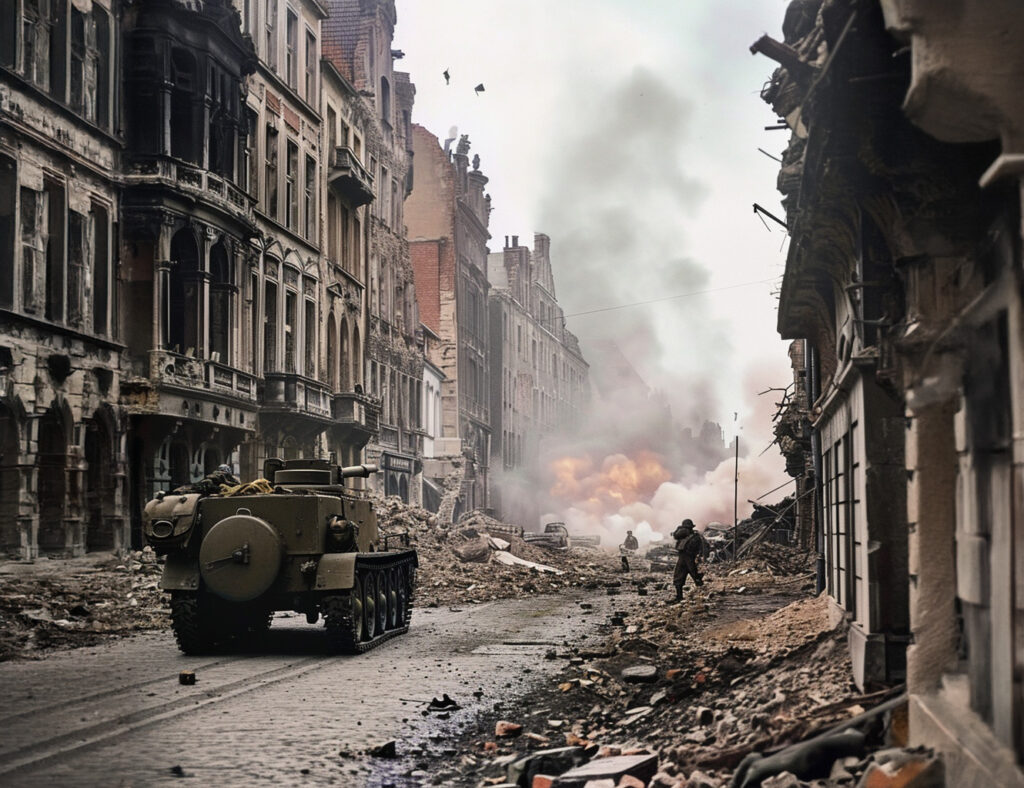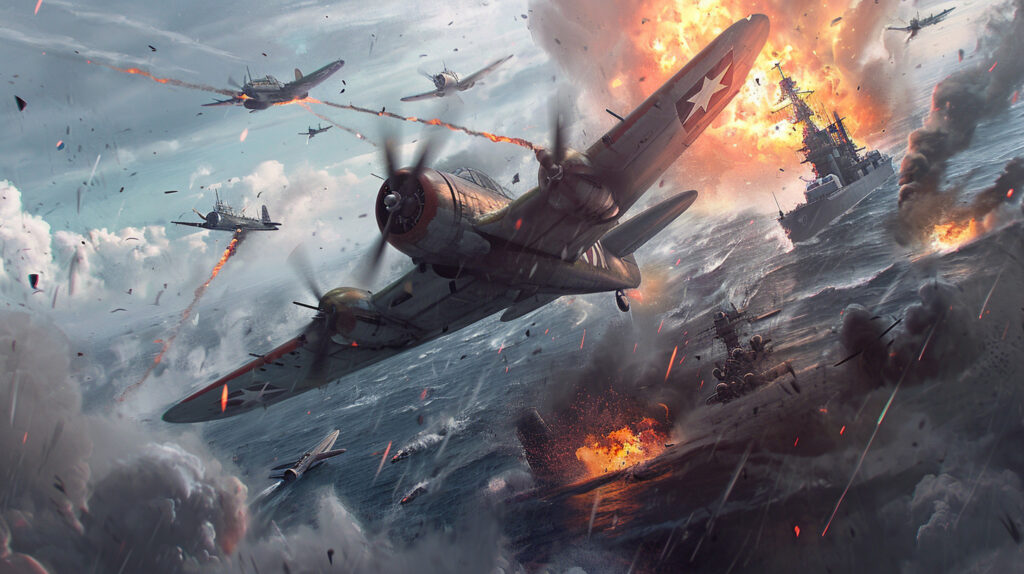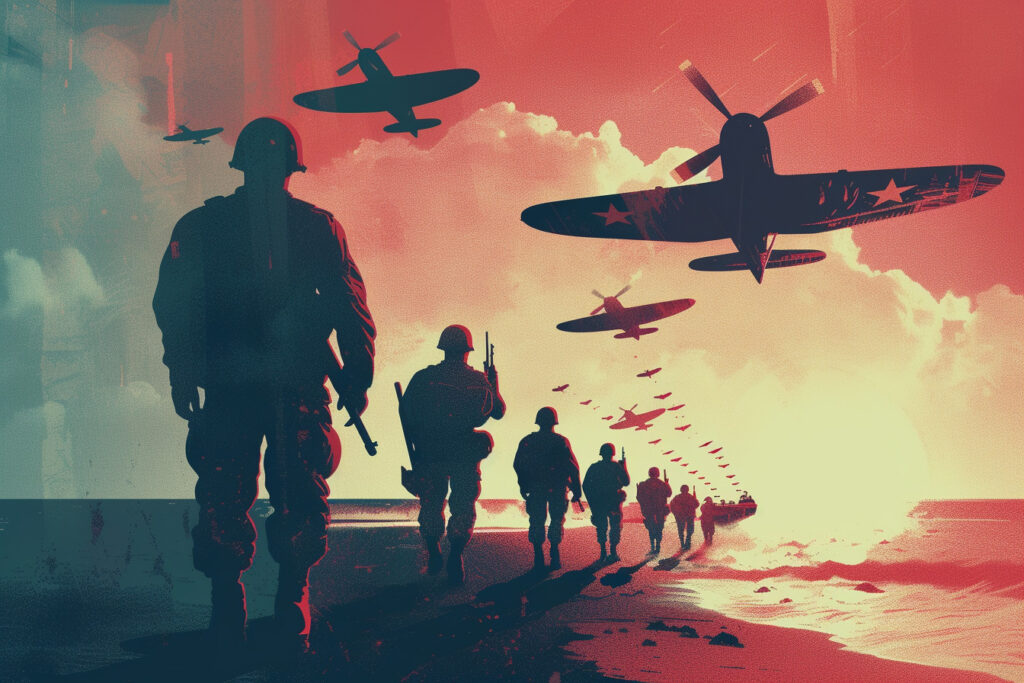World War II (1939-1945) was a global conflict involving major world powers. This article explores its causes, key figures, major battles, and lasting consequences.
World War II, spanning from 1939 to 1945, was a conflict of unparalleled scale and devastation. It engaged nations across the globe and altered the course of history. This war not only reshaped international borders and alliances but also left an indelible mark on the collective memory of humanity. Understanding its causes, key players, significant battles, and lasting impacts provides a comprehensive view of this transformative period.

Reasons for World War II (1939-1945)
The roots of World War II can be traced back to the aftermath of World War I and the Treaty of Versailles. The treaty imposed harsh penalties on Germany, including substantial territorial losses, military restrictions, and significant reparations. These conditions fostered economic hardship and nationalistic resentment within Germany. Additionally, the global economic downturn of the Great Depression further exacerbated political instability and social unrest.
The rise of totalitarian regimes in Germany, Italy, and Japan also contributed significantly to the outbreak of the war. In Germany, Adolf Hitler and the Nazi Party capitalized on economic woes and national humiliation, promoting an aggressive expansionist ideology. In Italy, Benito Mussolini sought to recreate the Roman Empire, and in Japan, militaristic leaders aimed to dominate East Asia.
Aggressive actions by these nations set the stage for conflict. Japan invaded Manchuria in 1931 and later China in 1937. Italy invaded Ethiopia in 1935. Germany’s annexation of Austria in 1938 and subsequent demands on Czechoslovakia’s Sudetenland were clear violations of the Versailles Treaty. The policy of appeasement, practiced by Britain and France, failed to curb these aggressions, emboldening Hitler. The immediate catalyst for the war was Germany’s invasion of Poland on September 1, 1939, prompting Britain and France to declare war on Germany.
Who Was Involved in World War II (1939-1945)
World War II was a truly global conflict, involving many of the world’s nations. The primary belligerents were the Allies and the Axis powers. The Allies primarily consisted of the United Kingdom, the Soviet Union, the United States, China, and France. These nations were later joined by numerous other countries, including Canada, Australia, New Zealand, India, and many others from Africa and Latin America.
The Axis powers were led by Germany, Italy, and Japan. These nations sought to expand their territories and influence through military conquest. Germany, under Hitler, aimed at establishing a vast European empire. Italy, led by Mussolini, sought to control the Mediterranean and parts of Africa. Japan, governed by a militaristic regime, pursued dominance over Asia and the Pacific.
Numerous other nations were either forced into the conflict due to invasions or joined in support of the primary belligerents. Smaller European countries like Poland, Norway, and the Netherlands were invaded and occupied by Axis forces. In Asia, countries like the Philippines, Burma, and Indonesia were battlegrounds between Japanese and Allied forces.
The involvement of these diverse nations turned the war into a truly global struggle, with battles raging across Europe, Africa, Asia, and the Pacific. The conflict’s scale and the vast array of participating countries highlight the war’s extensive impact on the world.
The Leaders of World War II (1939-1945)
Several prominent leaders played crucial roles in World War II, shaping its course and outcomes. Adolf Hitler, the dictator of Nazi Germany, was the primary architect of the war’s aggressive expansionist policies. His vision of a Greater German Reich and his genocidal policies led to the Holocaust and widespread destruction across Europe.
Winston Churchill, the British Prime Minister, became a symbol of resistance against Nazi aggression. His stirring speeches and unwavering resolve helped bolster British morale during the darkest days of the war. His leadership was pivotal during critical moments like the Battle of Britain and the Dunkirk evacuation.
Joseph Stalin, the leader of the Soviet Union, was instrumental in the defeat of Nazi Germany. Despite initially signing a non-aggression pact with Hitler, Stalin joined the Allies after Germany invaded the Soviet Union in 1941. His leadership during the Battle of Stalingrad marked a turning point in the war on the Eastern Front.
Franklin D. Roosevelt, the President of the United States, led the nation through its involvement in the war following the attack on Pearl Harbor in December 1941. His administration’s policies and the industrial might of the U.S. were crucial in supporting Allied efforts through initiatives like the Lend-Lease program.
Other notable leaders include General Dwight D. Eisenhower, the Supreme Allied Commander in Europe, who orchestrated the D-Day invasion; General Douglas MacArthur, who led Allied forces in the Pacific; and Emperor Hirohito of Japan, who was a figurehead during Japan’s military expansion and subsequent surrender.

Was There a Decisive Moment?
The invasion of Poland by Germany on September 1, 1939, was a decisive moment that transitioned rising tensions into full-scale war. This invasion, executed with the blitzkrieg strategy, quickly overwhelmed Polish defenses. Britain and France, bound by treaties to defend Poland, responded by declaring war on Germany on September 3, 1939. This marked the official start of World War II.
While the invasion of Poland was the immediate trigger, the war’s origins lay in years of mounting aggression and failed diplomatic efforts to maintain peace. The inability of the League of Nations to prevent invasions by Japan, Italy, and Germany demonstrated the weaknesses of interwar peacekeeping efforts. The failure of appeasement policies, especially at the Munich Conference in 1938 where Britain and France conceded the Sudetenland to Hitler, further emboldened the Axis powers. Thus, the invasion of Poland was not an isolated event but the culmination of escalating conflicts and diplomatic breakdowns.
Major Battles of World War II (1939-1945)
- Invasion of Poland (1939): Germany’s blitzkrieg tactics swiftly conquered Poland, leading to its division between Germany and the Soviet Union. This invasion prompted Britain and France to declare war on Germany, marking the beginning of World War II.
- Battle of France (1940): In May 1940, Germany launched a rapid invasion of France and the Low Countries. The fall of France in June 1940 shocked the world, leaving Britain to stand alone against the Axis powers in Western Europe.
- Battle of Britain (1940): From July to October 1940, the German Luftwaffe attempted to gain air superiority over Britain. Despite relentless bombing raids, the Royal Air Force successfully defended Britain, preventing a German invasion and marking Hitler’s first major defeat.
- Operation Barbarossa (1941): On June 22, 1941, Germany launched a massive invasion of the Soviet Union. The initial success of this surprise attack was halted by fierce Soviet resistance and harsh winter conditions. The failure of Barbarossa marked a significant turning point in the war.
- Pearl Harbor (1941): On December 7, 1941, Japan launched a surprise attack on the U.S. naval base at Pearl Harbor, Hawaii. This attack brought the United States into the war and united the American public in support of the Allies.
- Battle of Stalingrad (1942-1943): One of the deadliest battles in history, the Battle of Stalingrad saw the Soviet Union defeat the German Sixth Army. The surrender of German forces in February 1943 marked a critical turning point on the Eastern Front.
- Battle of El Alamein (1942): Fought in North Africa, this battle saw British forces under General Bernard Montgomery defeat the German Afrika Korps led by Erwin Rommel. The victory at El Alamein halted the Axis advance in Africa.
- Battle of Midway (1942): A pivotal naval battle in the Pacific, the U.S. Navy’s decisive victory over the Japanese fleet in June 1942 shifted the balance of power in the Pacific Theater in favor of the Allies.
- D-Day (1944): On June 6, 1944, Allied forces launched Operation Overlord, the largest amphibious invasion in history, on the beaches of Normandy, France. Led by General Dwight D. Eisenhower, this operation began the liberation of Western Europe from Nazi control.
- Battle of the Bulge (1944-1945): Germany’s last major offensive in the West, launched in December 1944, aimed to split Allied lines and capture the Belgian port of Antwerp. The Allies ultimately repelled the offensive, depleting German resources and hastening the war’s end.
Was There a Turning Point?
The Battle of Stalingrad (1942-1943) is widely considered the turning point of World War II. The Soviet victory ended Germany’s advance into the Soviet Union and marked the beginning of a series of defeats for the Axis powers on the Eastern Front. The encirclement and surrender of the German Sixth Army at Stalingrad dealt a severe blow to German military strength and morale. This victory, coupled with the Allied successes in North Africa and the Pacific, shifted the momentum in favor of the Allies, leading to a strategic advantage that they maintained until the war’s end.

Consequences of World War II (1939-1945)
The aftermath of World War II was profound and far-reaching. Europe was left in ruins, with millions of lives lost and entire cities devastated. The war led to the displacement of millions of people and the Holocaust’s horrifying revelations, which saw the systematic genocide of six million Jews and millions of other victims, left an enduring scar on humanity.
Politically, the war resulted in significant shifts in global power. The United States and the Soviet Union emerged as superpowers, leading to the Cold War’s ideological and geopolitical rivalry. The United Nations was established in 1945 to promote international cooperation and prevent future conflicts. The war also accelerated the decolonization process in Asia and Africa as weakened European powers could no longer maintain their colonial empires.
Economically, the Marshall Plan helped rebuild and stabilize Western Europe, fostering economic growth and cooperation. In contrast, Eastern Europe fell under Soviet influence, leading to the establishment of communist regimes. The war’s technological advancements, particularly in aviation, medicine, and nuclear energy, had lasting impacts on post-war society.
World War II was a cataclysmic event that reshaped the world in profound ways. The conflict’s causes, major battles, key figures, and outcomes illustrate a period of intense struggle and transformation. The war’s legacy continues to influence global politics, economics, and collective memory, underscoring the importance of understanding this pivotal chapter in history.
Back to the Wars section